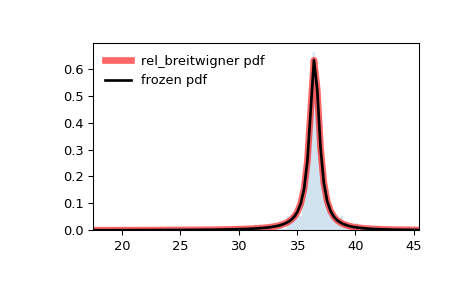scipy.stats.rel_breitwigner#
- scipy.stats.rel_breitwigner = <scipy.stats._continuous_distns.rel_breitwigner_gen object>[source]#
A relativistic Breit-Wigner random variable.
As an instance of the
rv_continuousclass,rel_breitwignerobject inherits from it a collection of generic methods (see below for the full list), and completes them with details specific for this particular distribution.Methods
rvs(rho, loc=0, scale=1, size=1, random_state=None)
Random variates.
pdf(x, rho, loc=0, scale=1)
Probability density function.
logpdf(x, rho, loc=0, scale=1)
Log of the probability density function.
cdf(x, rho, loc=0, scale=1)
Cumulative distribution function.
logcdf(x, rho, loc=0, scale=1)
Log of the cumulative distribution function.
sf(x, rho, loc=0, scale=1)
Survival function (also defined as
1 - cdf, but sf is sometimes more accurate).logsf(x, rho, loc=0, scale=1)
Log of the survival function.
ppf(q, rho, loc=0, scale=1)
Percent point function (inverse of
cdf— percentiles).isf(q, rho, loc=0, scale=1)
Inverse survival function (inverse of
sf).moment(order, rho, loc=0, scale=1)
Non-central moment of the specified order.
stats(rho, loc=0, scale=1, moments=’mv’)
Mean(‘m’), variance(‘v’), skew(‘s’), and/or kurtosis(‘k’).
entropy(rho, loc=0, scale=1)
(Differential) entropy of the RV.
fit(data)
Parameter estimates for generic data. See scipy.stats.rv_continuous.fit for detailed documentation of the keyword arguments.
expect(func, args=(rho,), loc=0, scale=1, lb=None, ub=None, conditional=False, **kwds)
Expected value of a function (of one argument) with respect to the distribution.
median(rho, loc=0, scale=1)
Median of the distribution.
mean(rho, loc=0, scale=1)
Mean of the distribution.
var(rho, loc=0, scale=1)
Variance of the distribution.
std(rho, loc=0, scale=1)
Standard deviation of the distribution.
interval(confidence, rho, loc=0, scale=1)
Confidence interval with equal areas around the median.
See also
cauchyCauchy distribution, also known as the Breit-Wigner distribution.
Notes
The probability density function for
rel_breitwigneris\[f(x, \rho) = \frac{k}{(x^2 - \rho^2)^2 + \rho^2}\]where
\[k = \frac{2\sqrt{2}\rho^2\sqrt{\rho^2 + 1}} {\pi\sqrt{\rho^2 + \rho\sqrt{\rho^2 + 1}}}\]The relativistic Breit-Wigner distribution is used in high energy physics to model resonances [1]. It gives the uncertainty in the invariant mass, \(M\) [2], of a resonance with characteristic mass \(M_0\) and decay-width \(\Gamma\), where \(M\), \(M_0\) and \(\Gamma\) are expressed in natural units. In SciPy’s parametrization, the shape parameter \(\rho\) is equal to \(M_0/\Gamma\) and takes values in \((0, \infty)\).
Equivalently, the relativistic Breit-Wigner distribution is said to give the uncertainty in the center-of-mass energy \(E_{\text{cm}}\). In natural units, the speed of light \(c\) is equal to 1 and the invariant mass \(M\) is equal to the rest energy \(Mc^2\). In the center-of-mass frame, the rest energy is equal to the total energy [3].
The probability density above is defined in the “standardized” form. To shift and/or scale the distribution use the
locandscaleparameters. Specifically,rel_breitwigner.pdf(x, rho, loc, scale)is identically equivalent torel_breitwigner.pdf(y, rho) / scalewithy = (x - loc) / scale. Note that shifting the location of a distribution does not make it a “noncentral” distribution; noncentral generalizations of some distributions are available in separate classes.\(\rho = M/\Gamma\) and \(\Gamma\) is the scale parameter. For example, if one seeks to model the \(Z^0\) boson with \(M_0 \approx 91.1876 \text{ GeV}\) and \(\Gamma \approx 2.4952\text{ GeV}\) [4] one can set
rho=91.1876/2.4952andscale=2.4952.To ensure a physically meaningful result when using the
fitmethod, one should setfloc=0to fix the location parameter to 0.References
[1]Relativistic Breit-Wigner distribution, Wikipedia, https://en.wikipedia.org/wiki/Relativistic_Breit-Wigner_distribution
[2]Invariant mass, Wikipedia, https://en.wikipedia.org/wiki/Invariant_mass
[3]Center-of-momentum frame, Wikipedia, https://en.wikipedia.org/wiki/Center-of-momentum_frame
[4]M. Tanabashi et al. (Particle Data Group) Phys. Rev. D 98, 030001 - Published 17 August 2018
Examples
>>> import numpy as np >>> from scipy.stats import rel_breitwigner >>> import matplotlib.pyplot as plt >>> fig, ax = plt.subplots(1, 1)
Calculate the first four moments:
>>> rho = 36.5 >>> mean, var, skew, kurt = rel_breitwigner.stats(rho, moments='mvsk')
Display the probability density function (
pdf):>>> x = np.linspace(rel_breitwigner.ppf(0.01, rho), ... rel_breitwigner.ppf(0.99, rho), 100) >>> ax.plot(x, rel_breitwigner.pdf(x, rho), ... 'r-', lw=5, alpha=0.6, label='rel_breitwigner pdf')
Alternatively, the distribution object can be called (as a function) to fix the shape, location and scale parameters. This returns a “frozen” RV object holding the given parameters fixed.
Freeze the distribution and display the frozen
pdf:>>> rv = rel_breitwigner(rho) >>> ax.plot(x, rv.pdf(x), 'k-', lw=2, label='frozen pdf')
Check accuracy of
cdfandppf:>>> vals = rel_breitwigner.ppf([0.001, 0.5, 0.999], rho) >>> np.allclose([0.001, 0.5, 0.999], rel_breitwigner.cdf(vals, rho)) True
Generate random numbers:
>>> r = rel_breitwigner.rvs(rho, size=1000)
And compare the histogram:
>>> ax.hist(r, density=True, bins='auto', histtype='stepfilled', alpha=0.2) >>> ax.set_xlim([x[0], x[-1]]) >>> ax.legend(loc='best', frameon=False) >>> plt.show()
